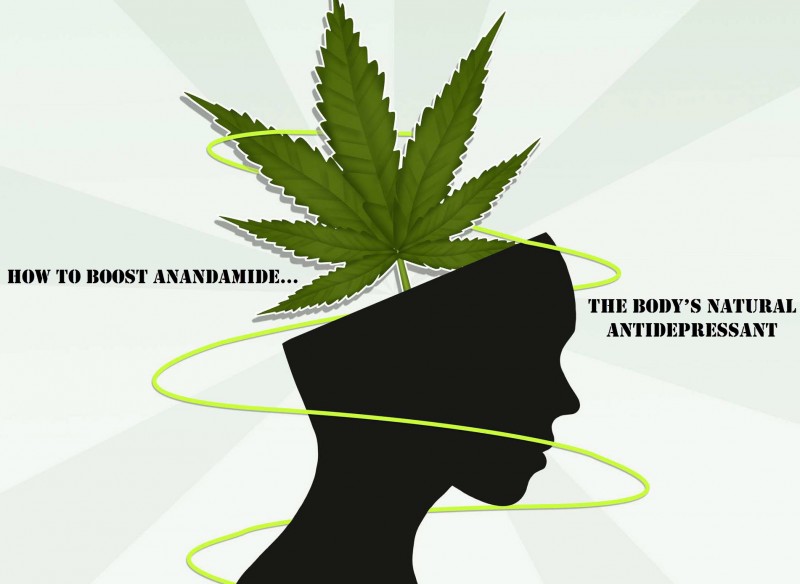How to Boost Anandamide, the Body’s Natural Antidepressant

The world is currently going through a global pandemic that’s threatening to disrupt not just everyday life but entire economic and healthcare systems. For millions of people around the world who are faced with anxiety and uncertainty about what tomorrow holds, the healing power of cannabis in its various forms can be a great way of dealing with the psychological, and maybe even physical, effects of the pandemic, naturally. One particular component in cannabis, an endocannabinoid called anandamide that’s known as the body’s natural antidepressant, could hold the key to helping people deal with these harrowing times.
From the Sanskrit word ‘ananda’, which means ‘internal bliss’, anandamide is an endocannabinoid that’s self-delivered by the brain and is metabolized by the endocannabinoid system, a recently discovered system that’s responsible for biosynthesis and is recognized as a modulator of a variety of processes, from pain and inflammation to appetite, and mood.
Anandamide is also a lipid mediator that functions as an endogenous ligand (a protein that binds to a recptor) by attaching itself to the body’s CB1 receptors, the primary molecular target that’s responsible for the pharmacological effects of THC.
Anandamide was discovered in the early ‘90s by Dr. Raphael Mechoulam, who was known for his groundbreaking research and discovery of delta-9-THC while trying to figure out why our bodies contained cannabinoid receptors that are capable of binding with external cannabinoids such as CBD and THC.
A few key findings that researchers have learned over the years about anandamide:
- The body creates it as it is needed for maintaining homeostasis, which it does by regulating neuron signaling and inflammation.
- Its molecular fragility makes it easily broken down. As a result, it doesn’t tend to stay in the body for very long.
- Its binding with CB1 and CB2 receptors hugely affects a range of physiological mechanisms like pain management, mood, appetite, and even fertility.
- It maintains homeostasis by binding to CB receptors and encouraging neurogenesis, the development of nerve cells in the brain, which is crucial for the formation of new nerve cells that are needed for functions like learning and memory.
- A 2009 study showed that high levels of anandamide are needed for ovulation and its fluctuation can affect fetal development. The study also found that higher levels of anandamide during ovulation can contribute to a successful pregnancy.
- In 2015, a study on humans and mice found that increased levels of endocannabinoid were catalysts for enhanced mood and reduced fear. In addition, an inhibited production of the enzymes responsible for breaking anandamide down (aka FAAH) resulted in a decrease in fear and anxiety during stressful times.
- Increased levels of anandamide are also responsible for the blissful high people experience after rigorous exercise, also known as ‘runner’s high’.
Now that we know what anandamide is, what can we do to boost it?
1. Eat foods that contain kaempferol
Kaempferol is a flavonoid that is found in a variety of fruits and vegetables such as potatoes, apples, broccoli, grapes, and tomatoes. Some studies suggest that kaempferol can fight cancer and also inhibit the production of FAAH, the enzyme that’s responsible for breaking down anandamide in the body.
2. Eat truffles!
A study done in 2015 found that truffles contain some of the major metabolic enzymes of the endocannabnioid system, despite not expressing any ECS-binding receptors. Researchers also found anandamide content in truffles at different levels of maturation. Meanwhile, the ECS’ other endogenous cannabinoid, 2-AG, was below the detection limit. Although truffles’ do come with a hefty price tag, so this may not be the most practical solution.
3. Exercise for at least 30 minutes
There’s a reason why some people get so addicted to exercise and running. Anandamide levels have been known to increase through exercise. Studies have also shown that the level of exercise and duration also matter, with low intensity exercises and shorter durations not shown to produce the same levels associated with what we call ‘runner’s high’. The production of anandamide is both motivation and reward for exercise, and, with the cardiovascular benefits associated with regular exercise, it makes it a win-win scenario. Feel happier and improve your health at the same time.
4. Take CBD
Cannabidiol is known for its potent anti-inflammatory and analgesic effects but equally as important are its anxiety reducing and mood boosting properties. Despite CBD’s weak binding affinity with ECS receptors, it’s been known to increase the levels of anandamide in the body by inhibiting the FAAH enzyme from breaking it down.
5. Indulge in dark chocolate
Ananadamide can be found, though in small amounts, in a chemical found in dark chocolate. It also contains two other chemicals that are similar to anandamide that slow down its breakdown, thus intensifying its effects. And unlike truffles, dark chocolate is decidedly more affordable.
MARIJUANA FOR ANTIDEPRESSANTS, READ MORE...
ANANDAMIDE AND THC AND CBD, WHAT IS THE DEAL? CLICK HERE.
OR...
ANTIDPRESSPANTS AND CANNABIS, YOU BET, READ THIS.








